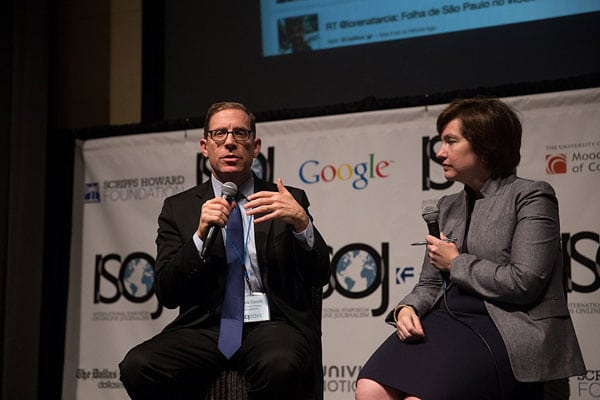
September 5, 2018; Columbia Journalism Review
Since its founding, the Texas Tribune has evolved “from a niche publication for hardcore policy wonks to a mainstream, establishment publication,” writes Chris O’Connell in the Columbia Journalism Review. Due in large measure to the backing of Austin venture capitalist John Thornton, the Texas Tribune has been an unusually prosperous nonprofit journalism outfit, raising $4 million before it launched. Led by CEO Evan Smith, who had spent nearly 18 years at the Texas Monthly, the publication launched in November 2009 with a staff of 17. By 2015, that staff had grown to 50 people and had “more full-time statehouse beat reporters (15) than any other news organization in the United States.”
The Texas Tribune has certainly become a field leader. A Knight Foundation report in 2015, titled Gaining Ground: How Nonprofit News Ventures Seek Sustainability, showed that the Texas Tribune, with its $7-million annual budget, had two-thirds of the budget of the other 19 profiled media organizations combined. Knight even commissioned a second report by Jake Batsell on the “Texas Tribune model” called Earning Their Keep: Revenue Strategies from the Texas Tribune and Other Nonprofit News Startups. At that time, NPQ noted that nonprofit journalism was still a field of toddlers, with foundations on average providing 58 percent of revenues. The Texas Tribune, in part by organizing large events—in 2017, it raised $2 million from 62 events, O’Connell reports—has reduced its foundation dependency, although it still relies heavily on donations. The publication’s membership now counts 4,399 individual donors.
It’s worth noting, however, that having money at the outset does not guarantee success. We all know of well-financed nonprofits that went nowhere. A year after raising the $4 million ($1 million of which came from Thornton), financial sustainability remained a major concern; as Batsell explains, it took a second $1 million contribution by Thornton (and related fundraising) to put the Texas Tribune on a truly sustainable path.
Today, nonprofit journalism’s prominence has risen. And the Tribune’s revenues, O’Connell reports, now total $8.7 million. O’Connell adds that the Tribune “expects to raise $9 million dollars between donors, grants, and members in 2018…and has posted double-digit percentages in revenue growth every year since its inception.”
The paper has also become an island of media stability in a sea of upheaval. Siva Vaidhyanathan, who had worked at the Austin American-Statesman, Dallas Morning News, and the Fort Worth Star-Telegram and now directs the University of Virginia Center for Media and Citizenship, says, “I’ve been overwhelmed by the fact that they are liberated to make news judgment the only judgment.”
In terms of audience, O’Connell reports that, “Bolstered by partnerships with the likes of The New York Times, Time, Cosmopolitan, and ProPublica, a monthly average of 1.9 million people read reporting that originates in the Tribune newsroom.” Partnerships have helped, including, O’Connell notes, a “joint venture with Cosmopolitan magazine for a piece on sex trafficking and another with the Weather Channel for a special report on Rockport, a Gulf Coast community that was decimated by Hurricane Harvey.”
In contrast, commercial media in Texas are suffering. As O’Connell details, “In May, 14 newsroom staffers were let go at the San Antonio Express News. The Dallas Morning News, where Texas Tribune Editor in Chief Emily Ramshaw cut her teeth, has already cut five positions this year…in March, GateHouse Media purchased the Austin American-Statesman; last month, the company offered voluntary buyouts to 200-plus employees….Next month, the American-Statesman will stop publishing Ahora Sí, its Spanish-language weekly.”
Sign up for our free newsletters
Subscribe to NPQ's newsletters to have our top stories delivered directly to your inbox.
By signing up, you agree to our privacy policy and terms of use, and to receive messages from NPQ and our partners.
The Texas Tribune might seem to be in a position to rest on its laurels. But its 15-page strategic plan is hardly cautious. Smith explains that the central goal between now and 2025 is to “develop specific audience and editorial strategies aimed at reaching and reflecting Texas’ fastest-growing populations: young and ethnically diverse Texans.” O’Connell adds that “there are corresponding pledges to diversify the Tribune staff; the strategic plan identifies Spanish-language skills as “a greater priority in hiring” going forward.
The top four objectives listed in the strategic plan are as follows:
Double and Diversify
Double our audience by deliberately pursuing readers in the fastest-growing population cohorts in Texas and by making editorial, platform and hiring decisions that better reflect the diversity of Texans.
Make Membership Our Mantra
Expand our membership program to twice its current size and value member conversion as our most important measure of audience engagement.
Put the Tech Back in Texas Tribune
Structure and train the organization for flexibility and collaboration, positioning the Tribune as a multimedia and technology innovator that doesn’t chase fads but makes smart choices today to maximize our options tomorrow.
Rev Up Revenue
Grow our operating revenue ambitiously year over year, with a greater emphasis on untapped major philanthropy and new and creative sponsor and events opportunities, and generate additional funds for innovation, for capacity-building and to shore up our reserves.
To realize these goals, O’Connell adds, the Tribune aims to raise $10 million by its 10th anniversary. “It is not an endowment, it is not to sit on the shelf. This is money to be deployed in service of this strategic plan,” Smith explains.—Steve Dubb











